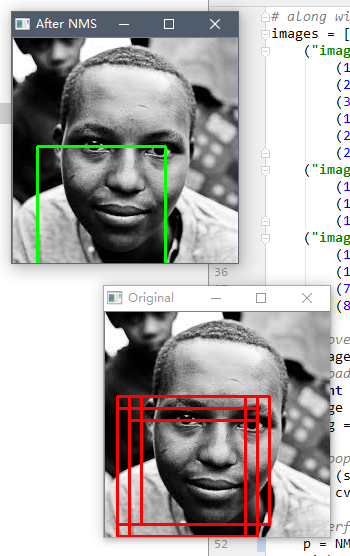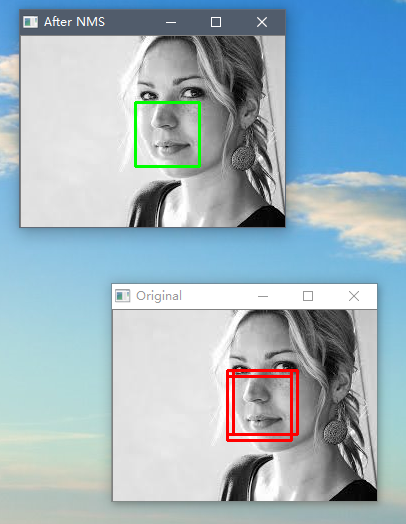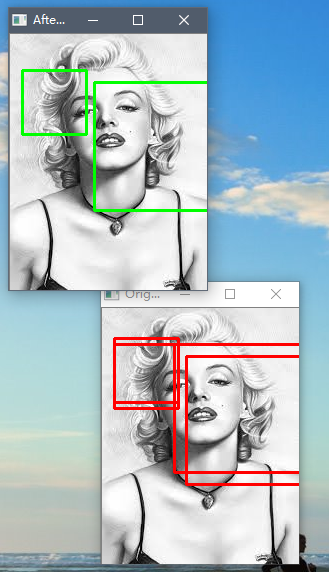机器学习中,使用NMS对框取优
一、NMS实现代码
# http://www.pyimagesearch.com/2015/02/16/faster-non-maximum-suppression-python/ import numpy as np class NMSuppression(object):
def __init__(self, bbs, overlapThreshold = 0.45):
self.bbs = bbs
self.overlapThreshold = overlapThreshold def _check_empty(self):
# return an empty list, if there are no boxes
if len(self.bbs) == 0:
return []
else:
return self.bbs def _check_dtype(self):
# if the bounding boxes integers, convert them to floats (divisions)
if self.bbs.dtype.kind == "i":
self.bbs = self.bbs.astype("float")
return self.bbs def bb_coordinates(self):
# get the coordinates of the bounding boxes
x1 = self.bbs[:, 0]
y1 = self.bbs[:, 1]
x2 = self.bbs[:, 2]
y2 = self.bbs[:, 3]
return x1, y1, x2, y2 def bb_area(self):
# compute the area of the bounding boxes
x1, y1, x2, y2 = self.bb_coordinates()
area = (x2 - x1 + 1) * (y2 - y1 + 1)
return area def calc_ovarlap(self, x1, y1, x2, y2, idxs, last, i, area):
# find the largest (x, y) coordinates for the start of
# the bounding box and the smallest (x, y) coordinates
# for the end of the bounding box
xx1 = np.maximum(x1[i], x1[idxs[:last]])
yy1 = np.maximum(y1[i], y1[idxs[:last]])
xx2 = np.minimum(x2[i], x2[idxs[:last]])
yy2 = np.minimum(y2[i], y2[idxs[:last]]) # compute the width and height of the bounding box
w = np.maximum(0, xx2 - xx1 + 1)
h = np.maximum(0, yy2 - yy1 + 1) # compute the ratio of overlap
overlap = (w * h) / area[idxs[:last]] return overlap def slow_suppress(self):
self._check_empty()
self._check_dtype() # initialize the list of picked indexes
picked = [] x1, y1, x2, y2 = self.bb_coordinates() # compute the area of the bounding boxes
area = self.bb_area() # sort the bounding boxes by the bottom-right y-coordinate of the bounding box
idxs = np.argsort(y2) # keep looping while some indexes still remain in the indexes list
while len(idxs) > 0:
# grab the last index in the indexes list, add the index
# value to the list of picked indexes, then initialize
# the suppression list (i.e. indexes that will be deleted)
# using the last index
last = len(idxs) - 1
i = idxs[last]
picked.append(i)
suppress = [last] # loop over all indexes in the indexes list
for pos in xrange(0, last):
# grab the current index
j = idxs[pos] # find the largest (x, y) coordinates for the start of
# the bounding box and the smallest (x, y) coordinates
# for the end of the bounding box
xx1 = max(x1[i], x1[j])
yy1 = max(y1[i], y1[j])
xx2 = min(x2[i], x2[j])
yy2 = min(y2[i], y2[j]) # compute the width and height of the bounding box
w = max(0, xx2 - xx1 + 1)
h = max(0, yy2 - yy1 + 1) # compute the ratio of overlap between the computed
# bounding box and the bounding box in the area list
overlap = float(w * h) / area[j] # if there is sufficient overlap, suppress the
# current bounding box
if overlap > self.overlapThreshold:
suppress.append(pos) # delete all indexes from the index list that are in the
# suppression list
idxs = np.delete(idxs, suppress) # return only the bounding boxes that were picked
return self.bbs[picked] def fast_suppress(self):
self._check_empty()
self._check_dtype() # initialize the list of picked indexes
picked = [] x1, y1, x2, y2 = self.bb_coordinates() # compute the area of the bounding boxes
area = self.bb_area() # sort the bounding boxes by the bottom-right y-coordinate of the bounding box
idxs = np.argsort(y2) # keep looping while some indexes still remain in the indexes list
while len(idxs) > 0:
# take the last index in the indexes list and add the
# index value to the list of picked indexes
last = len(idxs) - 1
i = idxs[last]
picked.append(i) overlap = self.calc_ovarlap(x1, y1, x2, y2, idxs, last, i, area) # delete all indexes from the index list that have
idxs = np.delete(idxs, np.concatenate(([last], np.where(overlap > self.overlapThreshold)[0]))) # return only the bounding boxes that were picked using the
# integer data type return self.bbs[picked].astype("int")
二、调用测试
#taken from: http://www.pyimagesearch.com/2014/11/17/non-maximum-suppression-object-detection-python
"""
Project parts (taken from the tutorial above):
1. Sampling positive images
2. Sampling negative images
3. Training a Linear SVM
4. Performing hard-negative mining
5. Re-training your Linear SVM using the hard-negative samples
6. Evaluating your classifier on your test dataset, utilizing non-maximum
suppression to ignore redundant, overlapping bounding boxes The sample images in this project are taken from the web (labeled as: no licensing needed for non-comertial use).
""" from nm_suppression import NMSuppression
import numpy as np
import cv2 # construct a list containing the images that will be examined
# along with their respective bounding boxes
images = [
("images/africa.jpeg", np.array([
(12, 84, 140, 212),
(24, 84, 152, 212),
(36, 84, 164, 212),
(12, 96, 140, 224),
(24, 96, 152, 224),
(24, 108, 152, 236)])),
("images/girl.jpeg", np.array([
(114, 60, 178, 124),
(120, 60, 184, 124),
(114, 66, 178, 130)])),
("images/monroe.jpeg", np.array([
(12, 30, 76, 94),
(12, 36, 76, 100),
(72, 36, 200, 164),
(84, 48, 212, 176)]))] # loop over the images
for (imagePath, boundingBoxes) in images:
# load the image and clone it
print "[x] %d initial bounding boxes" % (len(boundingBoxes))
image = cv2.imread(imagePath)
orig = image.copy() # loop over the bounding boxes for each image and draw them
for (startX, startY, endX, endY) in boundingBoxes:
cv2.rectangle(orig, (startX, startY), (endX, endY), (0, 0, 255), 2) # perform non-maximum suppression on the bounding boxes
p = NMSuppression(bbs=boundingBoxes, overlapThreshold=0.5)
pick = p.fast_suppress()
print "[x] after applying non-maximum, %d bounding boxes" % (len(pick)) # loop over the picked bounding boxes and draw them
for (startX, startY, endX, endY) in pick:
cv2.rectangle(image, (startX, startY), (endX, endY), (0, 255, 0), 2) # display the images
cv2.imshow("Original", orig)
cv2.imshow("After NMS", image)
cv2.waitKey(0)
三、效果



机器学习中,使用NMS对框取优的更多相关文章
- paper 126:[转载] 机器学习中的范数规则化之(一)L0、L1与L2范数
机器学习中的范数规则化之(一)L0.L1与L2范数 zouxy09@qq.com http://blog.csdn.net/zouxy09 今天我们聊聊机器学习中出现的非常频繁的问题:过拟合与规则化. ...
- 机器学习中的范数规则化之(一)L0、L1与L2范数(转)
http://blog.csdn.net/zouxy09/article/details/24971995 机器学习中的范数规则化之(一)L0.L1与L2范数 zouxy09@qq.com http: ...
- 机器学习中的范数规则化之(一)L0、L1与L2范数 非常好,必看
机器学习中的范数规则化之(一)L0.L1与L2范数 zouxy09@qq.com http://blog.csdn.net/zouxy09 今天我们聊聊机器学习中出现的非常频繁的问题:过拟合与规则化. ...
- 机器学习中的范数规则化-L0,L1和L2范式(转载)
机器学习中的范数规则化之(一)L0.L1与L2范数 zouxy09@qq.com http://blog.csdn.net/zouxy09 今天我们聊聊机器学习中出现的非常频繁的问题:过拟合与规则化. ...
- 机器学习中模型泛化能力和过拟合现象(overfitting)的矛盾、以及其主要缓解方法正则化技术原理初探
1. 偏差与方差 - 机器学习算法泛化性能分析 在一个项目中,我们通过设计和训练得到了一个model,该model的泛化可能很好,也可能不尽如人意,其背后的决定因素是什么呢?或者说我们可以从哪些方面去 ...
- 机器学习中的算法(2)-支持向量机(SVM)基础
版权声明:本文由LeftNotEasy发布于http://leftnoteasy.cnblogs.com, 本文可以被全部的转载或者部分使用,但请注明出处,如果有问题,请联系wheeleast@gma ...
- 机器学习中的规则化范数(L0, L1, L2, 核范数)
目录: 一.L0,L1范数 二.L2范数 三.核范数 今天我们聊聊机器学习中出现的非常频繁的问题:过拟合与规则化.我们先简单的来理解下常用的L0.L1.L2和核范数规则化.最后聊下规则化项参数的选择问 ...
- 机器学习中的损失函数 (着重比较:hinge loss vs softmax loss)
https://blog.csdn.net/u010976453/article/details/78488279 1. 损失函数 损失函数(Loss function)是用来估量你模型的预测值 f( ...
- 机器学习中的范数规则化 L0、L1与L2范数 核范数与规则项参数选择
http://blog.csdn.net/zouxy09/article/details/24971995 机器学习中的范数规则化之(一)L0.L1与L2范数 zouxy09@qq.com http: ...
随机推荐
- Android Butterknife框架
Android Butterknife框架 注解攻略 时间 2014-02-27 09:28:09 Msquirrel原文 http://www.msquirrel.com/?p=95 一.原理. ...
- 给hmailserver添加SSL支持
我们使用stunnel来给hmailserver添加ssl支持,stunnel是一个开源跨平台提供全局TLS/SSL支持的软件,它可以给很多本身不支持ssl的软件来提供安全的加密连接,同样可以用于hm ...
- 阿里云上部署kafka--遇到的坑
阿里云防火墙关闭,并且配置规则.不然会导致访问不到服务. 问题一: Caused by: java.net.UnknownHostException: iZuf68tztea6l5ccdz7wemZ: ...
- mongodb 脚本操作
MO='mongo'$MO << EOFuse testdbdb.dropDatabase()show dbsexit;EOF
- [国际A类会议] 2018最最最顶级的人工智能国际峰会汇总!CCF推荐!
copy from : http://www.sohu.com/a/201860341_99975651 如果今年的辉煌我们没有赶上,那么我们可以提前为明年的大会做准备.现在,AI脑力波小编就为大家 ...
- HTML5 本地文件操作之FileSystemAPI实例(三)
文件夹操作demo 1.读取根目录文件夹内容 window.requestFileSystem = window.requestFileSystem || window.webkitRequestFi ...
- 单因素方差分析(One Way ANOVA)
Analysis of variance (ANOVA) is a collection of statistical models and their associated estimation p ...
- c#使用QQ邮箱的SSL收发邮件
c#使用SMTP.QQ.COM的SSL验证时,收发邮件,请勿设置端口,代码如下: (1)虽然SSL端口是465,但是,在代码里,不能直接设置端口,很奇怪?挺奇怪,好吧腾讯SSL好像用的是587端口!! ...
- react-router的browserHistory/react-router-dom的BrowserRouter刷新页面404问题解决
前端解决: '/' 表示把所有的url都发给代理https://api.example.com bypass 表示不需要发给发给代理服务器的条件 如下配置,可以监听https://api.exampl ...
- Bluemix结合DevOps Service实现一键部署
林炳文Evankaka原创作品.转载请注明出处http://blog.csdn.net/evankaka 摘要:本文讲述了怎样通过Bluemix与DevOps Service相结合.来构建与部署一个持 ...
